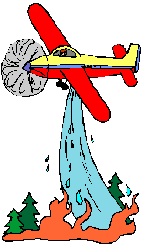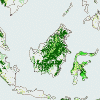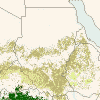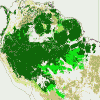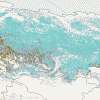 > ENC Master > Climate Encyclopaedia > Food & Climate > basics > 3. Drought in the Mediterranean > * Worksheet 2
> ENC Master > Climate Encyclopaedia > Food & Climate > basics > 3. Drought in the Mediterranean > * Worksheet 2
 |
|
|
|
|
Worksheet: Drought in the MediterraneanSheet 2: Reasons for vegetation fires |
|
Fire has always been a part of the ecosystem forest. But nowadays, there are more and more fires in forest than ever before. As long as the fire was caused by natural factors, the forests were able to recover after each fire and spread within their ancestral region. But this law of nature is invalid, since there are more and more vegetation fires around the globe, which reach a dangerous enormity. Even the evergreen tropical rainforest becomes a victim of flames. Due to conclusions by the WWF (World Wildlife Found) 95 % of all vegetation fires are caused by humans.
|
Each year more than 50.000 vegetation firesWWF calls for preventive measures to avoid fire catastrophes in Southern Europe |
After the disastrous vegetation fires at Corsica and the Côte d'Azur the increasing danger of fire catastrophes in the Mediterranean area becomes obvious. Even now 600.000 to 800.000 hectares of forest become a victim of flames every year, which is equivalent to the size of Crete. |
|
|
More than 50.000 fires destroy 1.5 % of the whole Mediterranean forest area in average per year. The great biodiversity in the Mediterranean area diminishes constantly and great fires, which mostly are not caused by nature, play a major role in their reduction. Due to conclusions of the WWF 95% of the fires are caused by humans, either by pure carelessness or mean intention. The other 5% are caused by natural processes. In countries like Spain, Italy, Portugal or Greece the number of vegetation fires has quadrupled since the 1960s.
|
|
Aside from human carelessness further main reasons are a change in land use and a massive expansion of the infrastructure of mass tourism. Urbanisation has superseded traditional forestry in the Mediterranean area. Arson has become a popular way to convert the areas which were once used for forestry into profitable building land. Longer lasting droughts, low humidity and extreme heat waves form a dangerous mixture. With the increase of vegetation fires the natural rate of regeneration of Mediterranean ecosystems declines. |
|
In many places a loss of biodiversity, scarceness of water, soil erosion and the formation of desert can be observed. Approximately 300.000 square kilometres of European coastlines are endangered. The danger of further vegetation fires rises by those facts. Also the reforestation is no perfect solution, as in copse and secondary forests so much dry wood accumulates, which is highly inflammable. To come up against the increasing danger of fire, strict laws and high penalties must be set up. Many of these 50000 fires of the following year can be prevented, if the governments start to rethink and spend their money for preventive measures instead of only paying for the extinguishing of blazing fires. An improvement of the cooperation of all institutions which are involved in the process of fire extinguishing is a first reasonable step. In many cases big fires could be prevented if the coordination of all had worked better. … (Based on an article by the WWF 2003 – source: http://www.wwf.de/presse/pressearchiv/artikel/01349/index.html) The FAO report however states, that "It has been observed, nevertheless, that the heavier the punishments provided by the law, the more difficult it is to prove arson and the more the courts hesitate to condemn arsonists". (http://www.fire.uni-freiburg.de/programmes/un/fao/Wp55_eng.pdf)
Exercise:1. What reasons for vegetation fires and consequences are mentioned in the text?2. Aside from the solutions described in the text, all humans can contribute to the protection of forests. Design a danger sign, which points out the danger of vegetatoinfires to the visitors and shows the most important behavioural rules (cigarettes, fire…)!
|
The global viewIn Europe the Mediterranean region often makes the haedlines in terms of vegetation fires ... but what importance does Europe have if you see fire events with a global view? Have a look on the world forest map below. Different type of forests are shown here in different countries. Click also on the thumbnails below, to see different regions in a higher resolution (70 K per image).
|
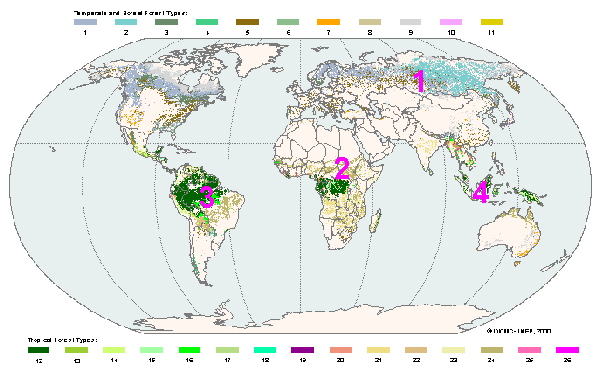 |
|
The global forest map
|
|
|
Thumbnails:
|
|
Exercise: Fires can be a catastrophy for the Mediterranean region. But of what importance are the Mediterranean fires for the world's climate? Fires on a global viewa) Every year in many countries of the African continent several million hectars burn, e.g. 7.5 Mio ha in the relatively small country Benin, where vegetation is traditionally burnt in order to transform it into agricultural land, and 60 Mio ha in Sudan with its wide savannahs. Partially such fires are part of a natural cycle (e.g. savannah fires) and the regrewing vegetation takes up again the carbon dioxide emitted from the fires, partially there is a long term damage basically due to human activity and transformation into agricultural lands. b) In the tropical Indonesia fires are often related to the drought during El Niño events. It is assumed that on Borneo 5 Mio ha of forest have been affected during the El Niño 1982/83, which is more than the area of Switzerland. During the El Niño 1997/1998 the situation was even worse. About 5 Mio ha were burnt only in the province East Kalimantan, 6.5 Mio ha in total Borneo. All the fires of 1997-1998 were human-caused. The majority of the fires were due to land speculation and large-scale forest conversion as a result of inadequate and unenforced land use policies. c) In Russia more than a quater of the size of whole Europe are covered by forests and partially forested areas (> 2500 Mio ha or 25 Mio km2), most of them boreal forest dominated by conifers. Due to successful fire management the area of burnt and dead land could be reduced from estimated 70 Mio ha in 1991 to about 30 Mio ha in 1991. But the statistics are not complete. d) The rainforest in Brazil experiences since decades a continuous deforestation by man. Here evergreen forest, which naturally would not burn, is cleared by humans and converted irreversibly into agricultural land. 400,000 km2 have been cleared until 1988, about 35,000 km2 per year is the estimated rate. In total more than the area of France has been destroyed up to now, releasing huge emissions to the atmosphere, which are not taken up again by regrewing vegetation. (Data from FAO report 2000) www.fire.uni-freiburg.de/programmes/un/fao/Wp55_eng.pdf (6 MB)
|
About this page:- Author: S. Ancot - University of Nürnberg - Germany, Elmar Uherek - MPI Mainz - Germany
|


